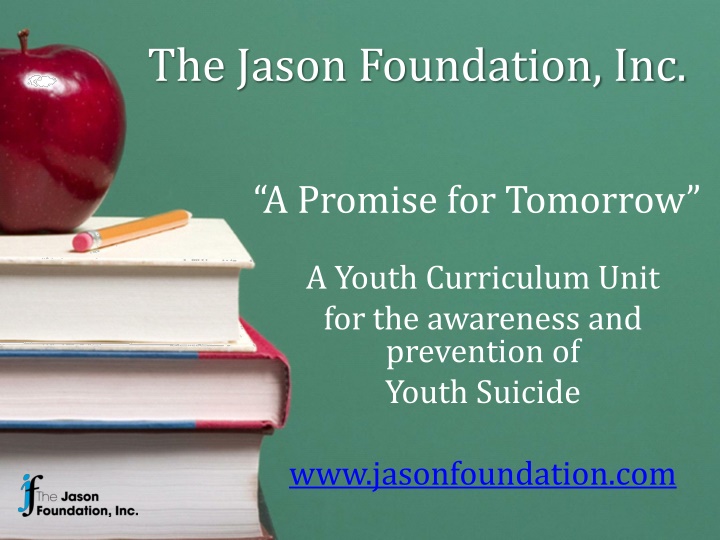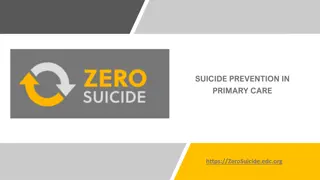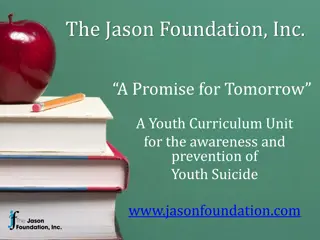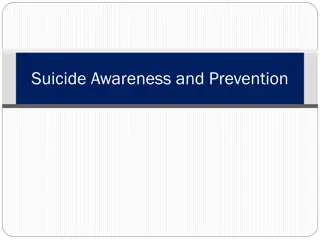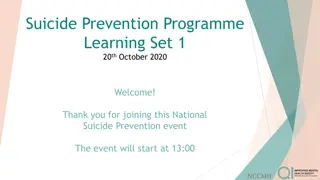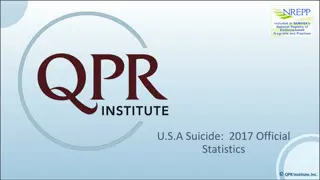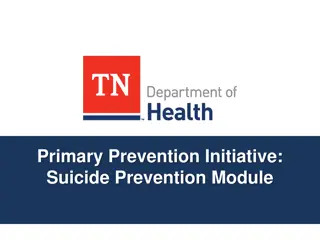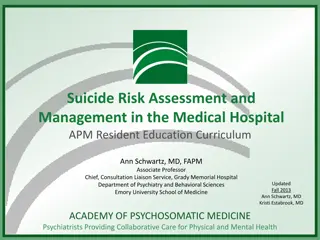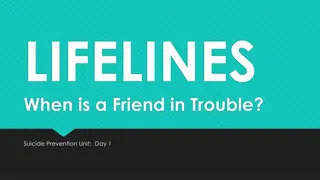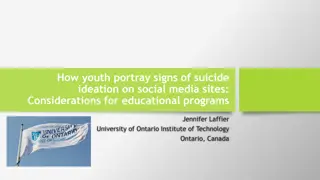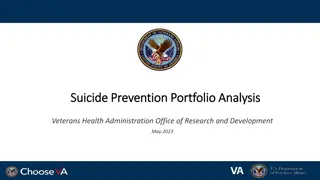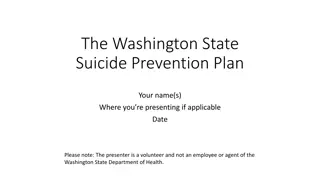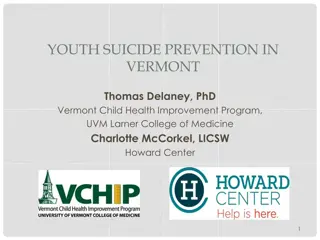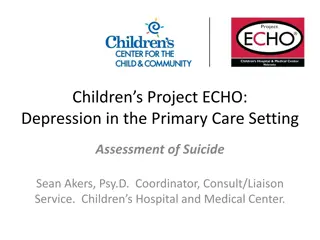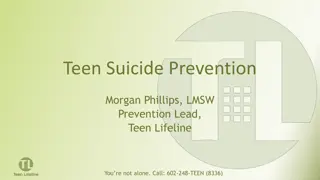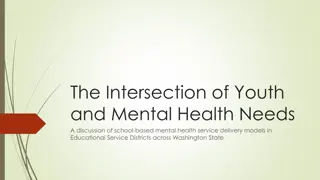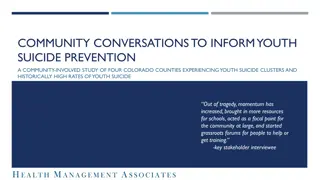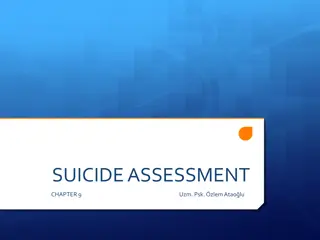Youth Suicide Prevention Curriculum - A Promise for Tomorrow
Explore the "A Promise for Tomorrow" youth curriculum unit by The Jason Foundation, aimed at raising awareness and preventing youth suicide. Learn about the importance of addressing this national health problem, the impact of suicide on young people, and key facts surrounding youth suicide through engaging lessons and questions.
Download Presentation

Please find below an Image/Link to download the presentation.
The content on the website is provided AS IS for your information and personal use only. It may not be sold, licensed, or shared on other websites without obtaining consent from the author.If you encounter any issues during the download, it is possible that the publisher has removed the file from their server.
You are allowed to download the files provided on this website for personal or commercial use, subject to the condition that they are used lawfully. All files are the property of their respective owners.
The content on the website is provided AS IS for your information and personal use only. It may not be sold, licensed, or shared on other websites without obtaining consent from the author.
E N D
Presentation Transcript
The Jason Foundation, Inc. A Promise for Tomorrow A Youth Curriculum Unit for the awareness and prevention of Youth Suicide www.jasonfoundation.com
A Promise for Tomorrow Lesson A
A Promise for Tomorrow In 1999, U.S. Surgeon General, Dr. David Satcher, declared suicide as a National Health Problem especially within the youth and elderly populations.
A Promise for Tomorrow Jason s Story
A Promise for Tomorrow Let s see what you already know about the problem of Youth Suicide.
Questions True or False
Question 1 Suicide is the SECOND leading cause of death among young people between the ages of 10 and 24.
Answer TRUE
In the United States How many young people do we lose, each year, to suicide?
It is estimated that We will lose approximately 5,000 young people to suicide each year.
Each week, We lose approximately 100 young people to the Silent Epidemic of youth suicide.
Question 2 People who talk about or threaten suicide rarely die by suicide.
Answer FALSE
Question 3 Approximately one young person dies by suicide every 2 hours.
Answer TRUE
Question 4 Talking to someone about suicidal feelings may cause them to attempt suicide.
Answer FALSE
Question 5 Suicide is Preventable.
Answer TRUE
Question 6 People who are contemplating suicide almost always tell someone beforehand.
Answer TRUE
In fact, Four out of five completed suicides gave clear warning signs before the attempt.
Youth Suicide Statistics Suicide is the second leading cause of death for young people, ages 10 to 24. (2016 CDC WISQARS) Suicide is the second leading cause of death for ages 12-18 and college-age youth.(2016 CDC WISQARS) Approximately 100 young people lose their lives to suicide in the U.S. every week. More teenagers and young adults are lost to suicide than die from cancer, heart disease, AIDS, birth defects, stroke, pneumonia, influenza and chronic lung disease, combined.
A Promise for Tomorrow Lesson B Choices
A Promise for Tomorrow Lesson C
Just a Bad Day or Something More Do you think everyone feels sad or down at times? When you felt sad or down, did you act differently than you normally do? How were you different? Did anyone notice the change in your behavior? Did you tell anyone how you were feeling? Who were you willing to talk to about your feelings? Who were you not willing to talk to about your feelings?
Signs of Concern Let s look at some signs of concern (warning signs) that may indicate a person might be having thoughts of suicide. Suicide Threats Previous Suicide Attempts Sudden Changes in Behavior Depression Final Arrangements
Suicide Threats I would be better off dead. You won t have me around to bother you much longer! I wish I was dead. I wish I could go to sleep and never wake up. I am going to kill myself. (This is very straight forward, but it happens.)
Previous Suicide Attempts One out of three completed suicides is not the first attempt. Physical mutilation (cutting) and/or other self-harm behaviors are a sign of wanting to hurt one s self physically to relieve an emotional pain it can sometimes lead to suicidal thoughts or attempts. Even if the attempt seems to be only for attention , take it as a serious cry for help and seek help immediately.
Sudden Changes in Behavior A loud person becomes quiet and reserved or a quiet person becomes loud and obvious. A person withdraws from activities he or she used to enjoy. A gentle person becomes aggressive and angers easily. An outgoing person becomes withdrawn. Declining grades or changes in class attendance.
Depression Feeling sad or hopeless every day for two weeks or longer Feelings of being alone or of no one caring Sleeplessness or wanting to sleep an abnormal amount of time Eating disorders - eating too much or not enough Lack of interest in activities once enjoyed
Final Arrangements Giving away prized possessions Favorite piece of jewelry or clothing Driver s license Collection cards, music, etc. Making rounds Visiting friends to set things right and / or say good-bye. Sharing of funeral plans Primarily by girls to a best friend.
A Promise for Tomorrow Lesson D Choices
A Promise for Tomorrow Lesson E
How to Help Someone you know may need a friend, B1. Be Aware, Be Able, and Be Prepared for their friends who may be struggling with suicidal thoughts.
B1 Program You can help a friend who may be struggling by learning about the problem of youth suicide and making a plan to help. Be Aware Be aware and understand the problem of youth suicide. Be Able to Identify Be able to identify a friend who may be hurting. Look for warning signs in your friend. Be Prepared to React Be prepared with a plan in place in the event that your friends display warning signs of suicide.
Resources for Help Favorite Teacher or Coach Parent Minister/Clergy Guidance Counselor Medical Doctor Other Trusted Adult Local Crisis Line Local Mental Health Center
Friends Helping Friends If you see any of the signs mentioned in a friend or a classmate, tell a responsible adult immediately. Be willing to risk your friendship to save a friend. REMEMBER Your knowledge of suicidal ideation could save someone s life.
The Jason Foundation, Inc. A Promise for Tomorrow A Youth Curriculum Unit for the awareness and prevention of Youth Suicide www.jasonfoundation.com
